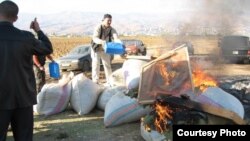23 December 2005 (RFE/RL) -- The drug problem seems to be primarily affecting the younger proportion of Lebanon's population of 3.8 million people, which, at a median age of 27, is in any case relatively youthful. A United Nations Office on Drugs and Crime assessment stated that almost 39 percent of the population is below the age of 19, and added that most drug abusers are men aged 25-34.
Mouna Yazigi, general manager of Oum el Nour, says that most first-time users are adolescents -- 58 percent of a 1,930 person sample was aged 14-19 -- and she cites statistics that show the age of patients is steadily falling, although she concedes that this could be attributed to the push for early detection of addiction. "Almost every year, we receive around 300 new cases," Yazigi adds.
Among them are addicts from the sizable Lebanese communities in South America, Australia, West Africa, the United States, Canada, and Europe. "We have a lot of Lebanese from abroad,” Yazigi says. Those who arrive from Africa do so because they have little confidence in the treatment programs there. Those from Australia, the United States, and Europe are sometimes the first generation to live abroad or the first generation to be born abroad. For them, it is easier to cope with treatment and rehabilitation in a Lebanese environment than in a foreign culture.
The Drugs Of Choice
Sixty percent of the patients at Oum el Nour are heroin addicts. Usually, though, they do not abuse just one substance. More than half of them also abuse cannabis; slightly less than half abuse cocaine. Increasingly popular among poorer addicts are inhalants. Also popular is Dulsana, a Lebanese cough syrup that has a high codeine content and is usually consumed in conjunction with alcohol, and Captagon, the trade name of an amphetamine-like central nervous system stimulant called fenethylline that is, because it is a prescription drug, relatively easy to secure.
Drug consumption patterns in Lebanon vary depending on family background and gender, Yazigi says. Usually, in families with more modern mores, a range of substances are abused, with LSD, mushrooms, and Ecstasy being popular. Locally produced ecstasy is inexpensive, at around 5,000 Lebanese pounds ($3.3) per pill. In this segment of Lebanese society, young addicts are like their peers anywhere else in the world, Yazigi believes: "they know everything about the drugs, they know exactly the effects,” and, in families that are aware of the addict's problem, “they discuss it with their parents."
In more traditional families, parents are less aware of the situation. "Drug addiction is very taboo,” Yazigi explains. “They don't discuss it." In this social group, less sophisticated drugs are commonly used. The drugs of choice are heroin and cannabis. Abuse of hard drugs is predominantly a male problem, with two male users for every female; the picture is reversed with prescription drugs, where women outnumber men two to one.
Assessment And Detoxification
Oum el Nour has a reception center that receives people with any kind of addiction -- not only drugs but alcohol as well. Yazigi described the process: "They can drop in or they can call the number. It can be the patients themselves or their parents -- or anybody who has any question about drugs. And there is here a team of psychologists, social workers, counselors. We also have a lawyer and a doctor."
The first step for new patients is to go through an assessment procedure at the reception center. The team then works with the patient to determine his goals and to tailor a treatment process. If the patient is ready to end his drug habit, the team then begins preparing him for the rehabilitation program. As the majority of patients are heroin addicts, the next step is to hospitalize them for detoxification.
Treatment And Rehabilitation
Oum el Nour has three residential centers -- two for men and one for women. The treatment is divided into phases, the first one being treatment for health issues. "The main objective is not only to stop [them taking] drugs, but to re-instill healthy habits, to [make them] part of society again," Yazigi says.
The second phase therefore focuses on social reintegration, a process in which Oum el Nour involves the addict’s family. A six-month phase then begins in which the patients are obliged to think about their ultimate objectives. "They start going out once a week, then twice a week, then maybe at the end they stay five days outside and two days inside, just to start planning their lives." This allows the patient to adapt slowly, make new friends, and mend bridges with their parents.
In Beirut, Oum el Nour also runs a follow-up center that patients can visit to take part in group sessions approximately once a week for 18 months. Patients sometimes also attend Narcotics Anonymous or Alcoholics Anonymous meetings. Parents too have access to group support, because, since addiction is taboo, parents have few, if any, other opportunities to discuss the issue. Parents “also need to be prepared to understand what addiction is and how to face their children, to receive them back again, to give them responsibility, and to treat them like a new man."
Treatment Alternatives
Oum el Nour is not the only counternarcotics organization in Lebanon. Jeunesse Anti-Drogue focuses on drug awareness, medical treatment, and outpatient rehabilitation. Jeunesse Contre la Drogue focuses on awareness and HIV/AIDS, and also directs patients towards treatment and rehabilitation facilities.
The declining age of Lebanese drug addicts suggests that these institutions will have to continue their work for a long time to come.









